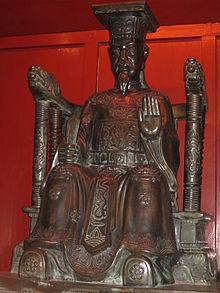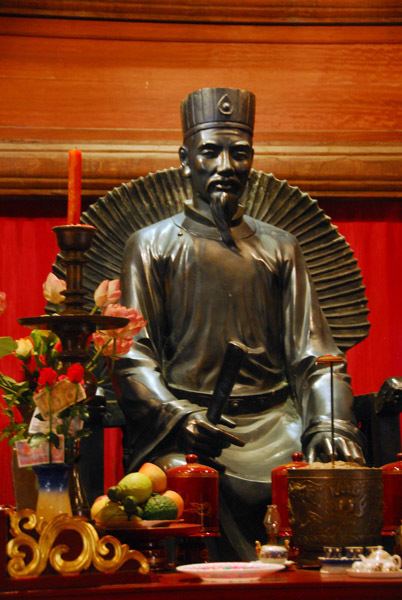Predecessor Ly Thai Tong Mother Empress Mai Thi Parents Ly Thai Tong Successor Ly Nhan Tong Name Ly Tong Children Ly Nhan Tong | Dynasty Ly Dynasty Role King Grandparents Ly Thai To Father Ly Thai Tong Died 1072 | |
 | ||
Great-grandparents Pham Thi, Hien Khanh Vuong Similar People Ly Nhan Tong, Y Lan, Ly Thai Tong, Ly Thai To | ||
P1/3 | King Lý Thánh Tông - The Compassionate Emperor
Lý Thánh Tông ([lǐ tʰǎːɲ toŋm]; born Lý Nhật Tôn [lǐ ɲə̀t ton], ruled 1054–1072) was the posthumous title of the third emperor of the Lý dynasty of Vietnam. Like his father, he was considered as one of the most talented and benevolent emperors in Vietnamese history.
Contents
- P13 King L Thnh Tng The Compassionate Emperor
- Genius Crown Prince
- Benevolent emperor
- Defeat of the Song invaders and conquest of Champa
- Era name
- References

Genius Crown Prince

He was the eldest son of Lý Thái Tông and his consort was known as Empress Mai Thị. He was born on February 25, 1023 (this date was followed the Lunar calendar, the official calendar of Vietnam during Vietnam's feudal period) at Càn Đức palace. In 1028, he was conferred Crown prince after his father ascended the throne.

He was soon adept in all main fields at that time, such as history, literature, music, and also martial arts. Like his father, he was soon brought out of the capital citadel to touch the bottom class in society, following the tradition of this dynasty. Living among the masses, he soon profoundly understand the wretchedness and the slavery below the legs of the emperor, making him have a benevolent reign after his succession.

Just at the age of 15, he was dubbed Great General, suppressed the revolt in Lam Tây (Lai Châu Province), and made some feat. When was 17 years old, his father allowed Thanh Tong to lead an army to conquest Nùng Tồn Phúc, he was in charge of the Regent to rule over the capital and to manage the affairs of court.

In 1040, when he was just 18, all important litigations over the nation were committed to him. One edifice known as Quảng Vũ palace was confided to him.
In 1043, he was again conferred as Great General to defeat Châu Ái (Thanh Hóa Province). One year later, while his father despatched the army to defeat Champa, he was again in charge of the Regent known as the title "The exarch of the capital."

In January 1045, when he was ailing, Lý Thái Tông allowed him to hold court. Two months later, Lý Thái Tông died and then Lý Nhật Tôn officially ascended.
Benevolent emperor
Just after succession, Lý Thánh Tông changed the national name from "Đại Cồ Việt" to "Đại Việt" (literally "Great Viet"), initiating the most prosperous epoch throughout the history of Vietnam under that name. Lý Thánh Tông mercifully managed the nation through his reign and spread his benevolence over his realm, even to prisoners. In one year, when it underwent an unomalously cold and long winter, he told his confidants that even he, being in the palace with enough clothing, still felt cold, so all prisoners, whether criminals or not, were not sufficiently supplied with either food or clothing, and easily deceased. Thus, he commanded his servants to bring food, mats, and blankets to these prisoners.
On another day, he was adjudicating some important cases. One of his young princesses was standing near him; he then indicated her and said that his love toward common people equaled that toward his offspring. He also said that the code was not stretched through the people so that they were ignorant and also could be innocent because of this ignorance. Thus the rigidity of the code must have been decreased and the laws must have been aimed at humanity.
His benevolence maintained the stability and the peace in the nation, and all individuals venerated him. He practiced Buddhism so during his reign, Lý Thánh Tông built many tower-pagodas and cast some large and impressive bells. However, he also had a comparative respect to Confucianism, and in order to civilize the people, he operated "Văn Miếu", the Temple of Literature, and commanded workmen to carve some large sculptures of Confucius and 72 sages. Since that, Vietnam has had Văn Miếu, the site to commemorate all people who have achieved the title "Tiến sĩ" (doctor).
His success was contributed to notably by his Noble Consort Ỷ Lan, who displayed great competence in administration. As Lý Thánh Tông did not soon produce an heir, when he went to war, she herself was left in charge of administering the nation.
Defeat of the Song invaders and conquest of Champa
After stabilizing the nation, he attended to the extension of his realm. He rearrayed the army and made army titles for each part of it. He totally divided his main cohort into 100 small groups and those were arrayed into four large groups: left, right, front, and rear, with supports of cavalries and trebuchets. The allotted army was assembled in another part. The tactical factor of the Đại Việt army at that time was an advance which was respected by the rivals.
In 1060, he commanded the exarch of "Lạng Châu" to combat the Song army along the border between two nations. The Vietnamese infantry won and captured the Song general ( Vietnamese: Dương Bảo Tài ). After some more failed conflict with Đại Việt, the Song sent an envoy to negotiate with the Đại Việt court. The negotiator was treated well, but Đại Việt peremptorily did not free that general.
As Champa constantly annoyed the area near the border between the two nations and sometimes intruded deeply to loot, in 1069 Lý Thánh Tông himself led an army to defeat Champa. He defeated the Cham army, burned Vijaya, and captured the King of Champa, Rudravarman III. Rudravarman III implored Lý Thánh Tông to release him in exchange for three areas, known as Địa Lý, Ma Linh, and Bố Chính. These now form part of Quảng Bình Province and Quảng Trị Province).
Era name
In January 1072, he suddenly died at the age of 50, ruled for 17 years. While he was ruling, he used 5 era names:
